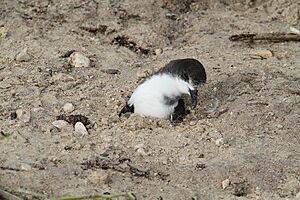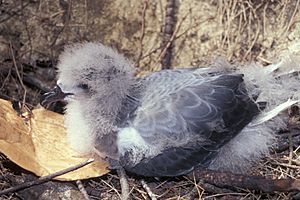Bonin petrel facts for kids
Quick facts for kids Bonin petrel |
|
|---|---|
 |
|
| On Midway Atoll | |
| Conservation status | |
| Scientific classification | |
| Genus: |
Pterodroma
|
| Species: |
hypoleuca
|
The Bonin petrel (Pterodroma hypoleuca) is a type of seabird that lives in the North Pacific Ocean. It belongs to the family called Procellariidae. This bird is a small "gadfly petrel," known for its quick and darting flight.
Because Bonin petrels live in secret places and breed on faraway islands, scientists don't know everything about them. They are quite mysterious birds!
Contents
What Does the Bonin Petrel Look Like?
The Bonin petrel is a small bird, about 30 cm (12 inches) long. Its wings can spread out to about 67 cm (26 inches). It has a white head with a black cap and dark marks on its face. This often makes its head look a bit "scaly."
Its upper body is light grey, but its main wing feathers and wing covers are darker. This creates a cool "M" shape across its back when it flies. The underside of its wings is white with dark edges and a dark spot near the "wrist" joint. Its tail is dark grey. The rest of its feathers are white, except for a dark half-collar on its chest.
Like other Pterodroma petrels, it has a short, hooked black beak. Its legs and feet are pink with some dark spots.
Where Do Bonin Petrels Live?
Bonin petrels live in the North Pacific Ocean. Most of them, about 99% of the total population, breed on the Northwestern Hawaiian Islands. This includes islands like French Frigate Shoals, Laysan, Lisianski Island, Pearl and Hermes Reef, Midway Atoll, and Kure Atoll.
A smaller group, about 1% of the population, breeds near Japan. They can be found on the Ogasawara and Volcano Islands.
How Do Bonin Petrels Behave?
What Do Bonin Petrels Eat?
Bonin petrels are special because they mostly eat fish. Most other petrels eat squid or crustaceans. Their favorite foods are lantern fish and hatchetfish. They also eat Squid from the Ommastrephidae family.
These fish and squid live deep in the ocean during the day. But at night, they swim closer to the surface to feed. Scientists believe Bonin petrels are nighttime hunters. They likely catch their prey from the surface of the water while resting or flying. Their eyes have a lot of a special pigment called rhodopsin, which helps them see well in the dark.
Bonin petrels usually hunt alone at sea. However, sometimes you might see them in large groups with other types of seabirds. Like all petrels, they can make a special "stomach oil" from their food. This oil is full of energy and lighter to carry than whole prey.
How Do Bonin Petrels Raise Their Young?

Bonin petrels nest in large groups called colonies. They choose islands in the Northwestern Hawaiian Islands and near Japan. The birds only visit their nesting colonies at night, usually arriving right after sunset.
They nest in winter to avoid competing for burrows with other seabirds. Sometimes, their nesting season overlaps with the larger wedge-tailed shearwater. These shearwaters might push Bonin petrel chicks out of their burrows or even harm them to take over the nest.
Both parents help dig their burrows. These nests are usually dug in sand or hard coral. They can be between 1 and 3 m (3 to 10 feet) long. Each pair defends a small area, about 2 m (6.5 feet) around their burrow entrance. They also tend to return to the same burrow year after year. If the burrow has collapsed, they will dig it out again. Burrows dug in hard coral are stronger and less likely to collapse than those in sand.
It's thought that Bonin petrels mate for life, just like other Procellariiformes. Before laying an egg, pairs fly together over the colony, chasing each other and calling out. Each pair lays only one egg per breeding season, usually in late January. If the egg is lost, they won't lay another one that year.
Both parents take turns sitting on the egg. The male incubates for about eight days, and the female for six days. The egg hatches after about 50 days, usually around mid-March. When they hatch, the chicks are covered in light grey down. The parents stay with the chicks for two days. After that, both parents go to sea to find food and return at night to feed their chick. They feed the chick stomach oil and small bits of prey. The chicks are ready to fly (fledge) about 80 days after hatching, usually in early June.
Do Bonin Petrels Migrate?
Yes, after the breeding season, both young and adult birds migrate north. They fly to the seas off Honshū and Sanriku in Japan. The timing of their journey depends partly on the ocean's temperature.
In August, the birds start to spread out south and east again. They begin to return to their breeding islands in September. During the breeding season, they feed in the waters around their nesting islands. These birds have never been seen in the eastern Pacific Ocean.
Bonin Petrels and Humans
Long ago, before people arrived, Bonin petrels used to nest on the main Hawaiian Islands. Scientists have found their bones on islands like Kauai, Oahu, and Molokai. These bones were found near places where early Polynesian settlers lived. This suggests that the petrels were a food source for them. However, the Bonin petrel disappeared from the main Hawaiian Islands before Europeans arrived.
Today, the biggest threat to Bonin petrels comes from introduced species, especially rats. Polynesian rats and black rats have caused big problems for Bonin petrel populations in the Northwestern Hawaiian Islands. They mainly do this by eating the petrel eggs. For example, on Kure Atoll, Polynesian rats were such a problem in the 1960s that not a single chick survived for five years! (Normally, about 90% of chicks hatch successfully when there are no predators.)
Similar problems happened on Midway Atoll. Black rats were introduced there in 1943. By 1995, they had reduced the Bonin petrel population from 500,000 birds to just 32,000. Rabbits were also introduced to Lisianski Island. They destroyed the nesting areas and made the burrows collapse. Losing their habitat also makes it harder for petrels to breed successfully. It also increases competition with more aggressive birds like the wedge-tailed shearwater.
Good news! People are working to protect the Bonin petrel and other seabirds on their breeding islands. Projects are underway to restore the native plants on Laysan and Midway. Also, rats and rabbits have been removed from all the Northwestern Hawaiian Islands. Because of these efforts, the Bonin petrel is currently listed as least concern by the IUCN. This means they are not in immediate danger of extinction.
See also
 In Spanish: Petrel de las Bonin para niños
In Spanish: Petrel de las Bonin para niños



